Knowledge
Lily bulb
Introduction:
Lily bulb is the bulb leaves of Lilium lancifolium under Liliaceae. Mainly grown in Hunan, China.
 Functions:
Functions:
Lily bulbs can nourish the Yin and the lungs, stop coughs and dyspnea, and calm the heart and the nerves. Good for those suffering from palpitate with fear, neurosis and insomnia.
Characteristics:
Sweet in taste, mild in nature.
Processing method:
Soak the Lily bulb for an hour in water and it is ready for cooking.
Way of storage:
Lily bulb should be stored in cool and dry place. If it is to be stored for some time before serving, it is better to place in refrigerator (0-8˚C).
Other notes:
Lily bulb (2 taels), White lotus seed (2 taels), Hasma (2 qian), Thai dried Longan (5 qian),Dried Red Dates (5 pieces), Rock sugar (adequate amount) → make into dessert for nourishing and giving youthful complexion, and nourishing the lungs and secreting more saliva.
Sweet and Bitter Almond kernels
Introduction:
Dried seeds of almond under Rosaceae. Sweet almond kernels are mostly used in making non-staple food, while bitter almond kernels are usually used for medicinal purpose. Both have food therapy effect. 4 taels of Sweet almond kernels plus 1 tael of bitter almond kernels means the Sweet and Bitter Almond kernels. Mainly produced in Hubei, China.
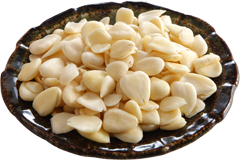 Functions:
Functions:
Sweet and Bitter Almond kernels can nourish the lungs and clear the phlegm and stop dyspnea. Nourishing and reducing accumulation. Suitable for externally-contracted coughs, irritability and shortness of breath, dryness in intestines that lead to constipation etc.
Characteristics:
Bitter in taste, warm in nature.
Processing method:
Soak the Sweet and Bitter Almond kernels for an hour in water and it is ready for cooking.
Way of storage:
Sweet and Bitter Almond kernels should be stored in cool and dry place. If it is to be stored for some time before serving, it is better to place in refrigerator (0-8˚C).
Other notes:
Sweet and Bitter Almond kernels (5 qian), Bulb of the Sichuan fritillary (5 qian), Dried scallops (4 pieces), Ginger (3 slices), Chinese Francolin (4), Lean pork (8 taels) → Make soup to nourish the lungs, stop coughing and invigorate the 5 organs.
Dried Longan
Introduction:
Dried Longan is also called Guiyuan, which is selected from Shixia Longan grown in Fujian Province of China, with thick flesh, sweet taste and small seed. Dried Longan can be used for cooking soup and desserts.
 Functions:
Functions:
Dried Longan can invigorate the heart and spleen.
Characteristics:
Sweet in taste, warm in nature.
Processing method:
Wash the Dried Longan in water and it is ready for cooking.
Way of storage:
The Dried Longan should be stored in cool and dry place. If it is to be stored for some time before serving, it is better to place in refrigerator (0-8˚C).
Other notes:
Dried Longan (5 qian), American ginseng (5 qian), Dried Red Dates (5 pieces),Black Skin Chicken (1) → Make into soup to invigorate the spleen and vital energy, nourish the blood and stimulate saliva secretion.
Black Dates
Introduction:
Black Dates are the ripen fruits of Ziziphus under Rhamnaceae. Mainly produced in Jiejiang, China.
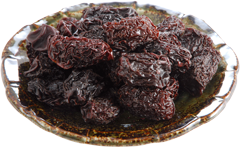 Functions:
Functions:
Black Dates invigorate the spleen and harmonize the stomach, replenish the vital energy and blood, as well as pamper the blood and nerves. Suitable for those with weak spleen and stomach, yellow complexion and women after giving birth.
Characteristics:
Sweet in taste, warm in nature.
Processing method:
Wash the Black Dates in water, remove seeds and it is ready for cooking.
Way of storage:
Black Dates should be stored in refrigerator (0-8˚C). If it is to be stored for some time before serving, it is better to place in freezer (-18˚C).
Other notes:
Black Dates (1 tael), Radix astragali (4 qian), Preserved Mandarin Orange Peel (1 small piece), Ginger (3 slices), Chinese Soft-shelled Turtle (1), Lean pork (8 taels) → Make soup to nourish the liver and kidneys, replenish the vital energy and blood.
Red Dates
Introduction:
Red Dates are the ripen fruits of Ziziphus under Rhamnaceae. Divided into "Sai Ho Dates" and "Chicken heart dates (Dried Red Dates)". Mainly produced in Henan, China.
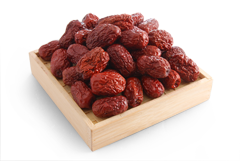 Functions:
Functions:
Red Dates invigorate the spleen and harmonize the stomach, pamper the blood and nerves, supplements the middle and invigorates vital energy. Suitable for those with weak vital energy and blood, anemia, insomnia and neurosis.
Characteristics:
Sweet in taste, warm in nature.
Processing method:
Wash the Red Dates in water, remove seeds and it is ready for cooking.
Way of storage:
Red Dates should be stored in refrigerator (0-8˚C). If it is to be stored for some time before serving, it is better to place in freezer (-18˚C).
Other notes:
Dried Red Dates (10 pieces), Gutian snow fungus (5 qian), Ginger (3 slices), Pigeon (1), Lean pork (8 taels) → Make soup to nourish liver and kidneys, replenish the blood and nourish the lungs.
Preserved Mandarin Orange Peel
Introduction:
Preserved Mandarin Orange Peel is made from the dried skin of citrus fruits under Rutaceae. For medicinal use, older peels are preferred. Mainly produced in Xinhui, Guangdong, China.
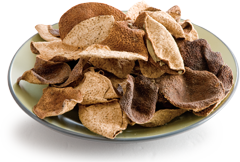 Functions:
Functions:
Preserved Mandarin Orange Peel can regulate the vital energy, remove the phlegm, disperse dampness and strengthen the spleen, regulate the flow and prevent vomiting. Good for indigestion, losing appetite and vomiting and too much phlegm and coughs.
Characteristics:
Sweet and spicy in taste, warm in nature.
Processing method:
Soak the Preserved Mandarin Orange Peel in water for an hour until softened and remove seeds. Rinse clean and it is ready for cooking.
Way of storage:
Preserved Mandarin Orange Peel should be stored in cool and dry condition.
Other notes:
Preserved Mandarin Orange Peel (2 qian), Dried Red Dates (5 pieces), Ginger (2 slices), Naked duck (1) → Make soup to nourish the Yin and blood, regulate the vital energy and stomach.
Preserved Mandarin Orange Peel – Myths & Facts
Walnut
Introduction:
Walnut is the seed of Juglandaceae plants. Crack the shell open and clear the septum to get the fruit part (walnut fruit). Mainly produced in Yunnan, China.
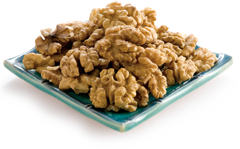 Functions:
Functions:
Walnut warms the lungs and supplements kidneys, stop dyspnea, remove phlegm, nourish the dryness and intestines. Good for insomnia, forgetfulness, weak in kidneys, waist pain and coughs due to coldness etc.
Characteristics:
Sweet in taste, warm in nature.
Processing method:
Soak the walnut for 1 hour in water, rinse and it is ready for cooking.
Way of storage:
Walnut should be stored in cool and dry place. To preserve better quality, it is suggested to be sealed with sealed stick and placed in refrigerator (0-8˚C) after opening. Please serve it as soon as possible.
Other notes:
Walnut (2 taels), South Dates (1 tael), Black Sesame (5 qian), Peanuts (2 taels), Pig's bones (1 catty) → Make soup with the above ingredients for nourishing the kidneys and the bones, supporting the brain and growing of hair.
Cashew Nuts
Introduction:
Cashew Nuts are the fruits of cashew trees with their hard shells removed. Mainly produced in India and Thailand.
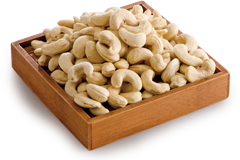 Functions:
Functions:
Cashew Nuts supplement body energy and removes tiredness. Rich in polyunsaturated fats, proteins and various vitamins. Good for blood vessels and heart. Fresh cashew nuts also serves to promote water circulation and remove swollen parts.
Characteristics:
Sweet in taste, mild in nature.
Processing method:
Wash the cashew nuts with water; add salt to boil, press dry and it is ready for cooking.
Way of storage:
Cashew Nuts should be stored in cool and dry place. If it is to be stored for some time before serving, it is better to place in refrigerator (0-8˚C).
Other notes:
Cashew nuts are one of the most famous dried fruits in the world (walnut, bitter almond and hazelnut), tasting fresh and nice. Good for frying, soak in salt or sweet.
White Lotus Seeds
Introduction:
White Lotus Seeds are the seeds of Lotus under Nymphaeaceae. Remove the outer shell while it is still fresh, and remove the inner membrane. Take the core out and dry it. Mainly produced in Fujian, China.
 Functions:
Functions:
White Lotus Seed promotes spleen functions, strengthen the stomach, comforts the mental, supplements the kidneys and stabilizes the essence. Suitable for losing appetite, palpitations, flustered, weak spleen causing prolonged diarrhea.
Characteristics:
Sweet in taste, mild in nature.
Processing method:
Soak the White Lotus Seed in water for an hour or above; rinse and it is ready for cooking.
Way of storage:
White Lotus Seed should be stored in cool and dry place. If it is to be stored for some time before serving, it is better to place in refrigerator (0-8˚C).
Other notes:
White Lotus Seed (2 taels), Lily Bulb (1 tael), Zhangzhou snow fungus (5 qian), Thai dried Longan (1 tael), Quail eggs (10), Rock sugar (appropriate amount) → Make dessert with the above to nourish the lungs, stimulate saliva, comfort and heart and nerves.
Semen Euryales
Introduction:
Dried seeds of Semen Euryales under Nymphaeaceae. Mainly produced in Xiaoxing, Guangdong, China, thus also called "Xiao shi (seed)".
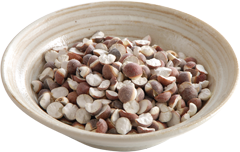 Functions:
Functions:
Semen Euryales supplements the spleen, stops diarrhea, removes dampness and white vaginal secretions, retracts and stops sweating. Suitable for those with weak spleen and prolonged diarrhea or white vaginal secretions.
Characteristics:
Sweet in taste, mild in nature.
Processing method:
Soak the Semen Euryales in water for an hour or above; rinse and it is ready for cooking.
NOTE: This product has been processed by sulphur. Must be soaked in water before cooking, or else sour taste may appear.
Way of storage:
Semen Euryales should be stored in cool and dry place. If it is to be stored for some time before serving, it is better to place in refrigerator (0-8˚C).
Other notes:
Semen Euryales (1 tael), Henan Chinese Yam (1 tael), Sweet and Bitter Almond kernels (5 qian), Preserved Mandarin Orange Peel (1 small piece), Ginger (3 slices), Bartail Flathead (Platycephalus indicus) (1), Lean pork (8 taels) → Make into soup to strengthen the spleen and calm the stomach, nourish the lungs and kidneys.
Salt Dried Semen Euryales
Introduction:
Salted Dried seeds of Semen Euryales under Nymphaeaceae. Mainly produced in Xiaoxing, Guangdong, China, thus also called "Xiao shi (seed)".
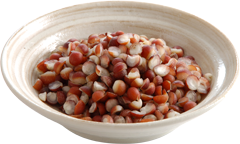 Functions:
Functions:
Salted Dried Semen Euryales supplements the spleen, removes dampness, invigorates the kidneys and essences, nourishes and strengthens the body. Suitable for those with weak spleen and kidneys or frequent night urination.
Characteristics:
Sweet in taste, mild in nature.
Processing method:
Soak the Semen Euryales in water for an hour or above; rinse and it is ready for cooking.
NOTE: This product has been processed by sulphur. Must be soaked in water before cooking, or else sour taste may appear.
Way of storage:
Salted Dried Semen Euryales should be stored in cool and dry place. If it is to be stored for some time before serving, it is better to place in refrigerator (0-8˚C).
Other notes:
Salted Dried Semen Euryales (1 tael), Cortex Eucommiae (5 qian), Radix Pseudostellariae (Prince Ginseng) (5 qian), Henan Chinese Yam (1 tael), Ningxia Wolfberry (5 qian), Thai Dried Longan (5 qian), Herba Cistanches (5 qian), Pig's bone (1 catty) → Make into soup for strengthening the spleen, regulating vital energy, nourishing the liver and kidneys.
Pine nuts
Introduction:
Seed cores of the pine fruits. Removing the shell and inside you find the white part. Mainly produced in Northeast China.
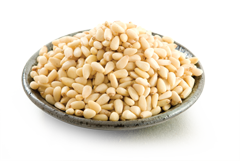 Functions:
Functions:
Pine nuts nourish and strengthen the body, nourish the lungs and intestines. Rich in proteins and fats, plus minute amount of sugar and minerals. Suitable for those suffering from dizziness or dry cough.
Characteristics:
Sweet in taste, mild in nature.
Processing method:
Rinse Pine nuts with water and dry them. Ready for cooking.
Way of storage:
Pine nuts should be stored in cool and dry place. If it is to be stored for some time before serving, it is better to place in refrigerator (0-8˚C).
NOTE: Take care of the air, moisture and temperature when storing. If the center part becomes greenish, it means it starts to turn bad.
Other notes:
When fried, pine nuts can be used in cakes and candies or into a sweet dessert with glutinous rice. Can add honey to stew after frying with other nuts to prepare a nuts syrup. Also can be fried with vegetables, meat and seafood.
Momordica grosvenori Swingle
Introduction:
Luo Han Guo is the ripen fruit of Momordica grosvenori under Cucurbitaceae. Mainly produced in Wuzhou, Guangxi, China.
 Functions:
Functions:
Momordica grosvenori removes heat and symptoms due to hot weather, nourishes the lungs and stops cough, refreshes and stimulates saliva secretion. Suitable for cough due to heat in lungs, dryness of mouth and throat. Relief of sore throat and coarse voice.
Characteristics:
Sweet in taste, cold in nature.
Processing method:
Cut into halves and wash with water. Ready for cooking.
Way of storage:
Luo Han Guo should be stored in cool and dry place.
Other notes:
Luo Han Guo (half), Sweet and bitter almond kernels (5 qian), Preserved Mandarin Orange Peel (1 small piece), Ginger (2 slices), Watercress (12 taels), Snakehead fish (1), Lead pork (8 taels) → Make soup with the above ingredients to clear heat, nourish lungs, supplement the liver and kidneys.
Laver
Introduction:
The leaf-like part of Porphyra Bangiaceae. Delicious and suitable for both food and medicinal use. Also called the "longetivity seaweed". Mainly produced in Fujian, China.
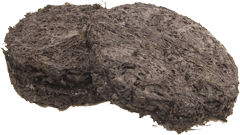 Functions:
Functions:
Laver removes phlegm and disperses clumps, removes heat from body and promotes water circulation to reduce swollen parts. Rich in nutrients and proteins. Suitable for thyroid gland inflammation, blocking in urination and beriberi.
Characteristics:
Sweet and salty in taste, cold in nature.
Processing method:
Soak the Laver in water for about 10 minutes, rinse to remove impurities and it is ready for cooking.
Way of storage:
Laver should be stored in cool and dry place. If it is to be stored for some time before serving, it is better to place in refrigerator (0-8˚C).
Other notes:
Laver (2 sheets), Dried scallops (4 pieces), Ginger (2 slices), Lean pork (8 taels), → Make quick soup with the above ingredients to nourish the Yin, clear the heat, invigorate the spleen and activate the stomach.
Sword flower
Introduction:
Sword flower is the blossom of Hylocereus undatus under Cactaceae. Mainly produced in Guangdong, China.
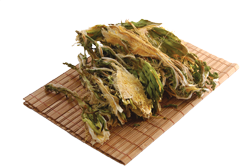 Functions:
Functions:
Sword flower removes the heat and phlegm, and clears accumulated heat in stomach and intestines. Suitable for those feeling the stomach swollen, constipation or face and ears red.
Characteristics:
Sweet and light in taste, cool in nature.
Processing method:
Soak the Sword flower for an hour in water. Cut to remove hard parts in the bottom. Rinse and ready for cooking.
NOTE: This product has been processed by sulphur. Must be soaked in water before cooking, or else sour taste may appear.
Way of storage:
Sword flower should be stored in cool and dry place. If it is to be stored for some time before serving, it is better to place in refrigerator (0-8˚C).
Other notes:
Sword flower (2 taels), Sweet and bitter almond kernels (5 qian), Golden dates (4 pieces) Lead pork (1 catty) → Make soup to remove heat, stimulate saliva, nourish the lungs and stop coughing.
Jinhua Ham
Brief Introduction:
Jinhua ham is a preserved product of the hind thighs of Jinhua two-end-black, a famous pig pedigree mainly from Jinhua, Zhejiang, China. The ham is characterized by its thin skin, small bones, plump thighs, and fresh and tender meat. Most of the ham is lean meat with little fat. It has a pleasant aroma.
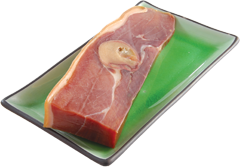 Efficacy:
Efficacy:
Jinhua ham has kidney-tonifying, stomach-benefiting, fluid-engendering, deficiency-treating, yang-enriching, and bone-strengthing properties. It is rich in nutritious ingredients, including abundant proteins and amino acids.
Characteristics:
Tastes sweet and salty and in mild nature.
Procedures:
Soak the product in clear water for a while. Clean it. Then, it will be ready for cooking.
Storage Method:
Jinhua ham should be stored in a ventilated and cool place. If the ham is to be consumed over a long period of time, it is suggested that it should be sealed and chilled (at 0-8°C).
Supplementary Information:
Jinhua ham loaf is deboned and its skin is peeled. The product is vacuum packaged and is therefore clean and in hygiene condition. It should be cooked before serving. Cook it with sugar for about 10 minutes and cut it into slices. It will be a good appetizer to accompany wine.
Suggested cooking method:
Jinhua ham (40g), fish maw (75g), frozen conch (454g), ginger (2 slices), spring onion (1 stalk), chicken soup (2 tablespoons), and lean pork (300g), used as ingredients of a soup. According to dietotherapy, the soup is yin-enriching, kidney-tonifying, qi-replenishing, and providing youthful complexion.
Nanan Duck Kidney
Introduction:
Duck kidneys are made by processing and drying fresh duck kidney, also called "Chenshen" in Chinese. They are sweet, delicious and always used as ingredients of soups. They are mainly produced in Nanjing, Jiangsu, China.
 Functions:
Functions:
Duck kidneys have spleen-fortifying, appetite-improvement, and digestion-promoting properties. They are nutritious and rich in proteins, fat, and various minerals.
Characteristics:
Sweet taste and in mild nature.
Processing method:
Soak the duck kidneys in clear water for about 1-2 hours (depending on the size), cut and clean them. Then they will be ready for cooking.
Way of storage:
Duck kidneys should be chilled (at 0-8°C) for storage. If they are to be consumed over a long period of time, it is suggested that they are sealed and frozen (at -18°C or below).
Suggested Serving:
Duck kidneys (3 pieces), golden candied dates (4 pieces), watercress (450g), ginger (2 slices), snake head fish (1 fish), lean pork (300g) → used as ingredients of soups. The soup has heat and toxins removing, moistening, spleen-fortifying and qi-tonifying properties.
Pork Tendon
Brief Introduction:
Pork tendon, also called Zhutijin in Chinese, is made by processing and drying fresh pork tendon. The product is mainly produced in Sichuan, China.
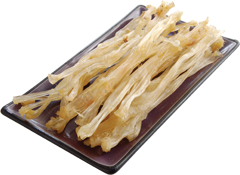 Efficacy:
Efficacy:
Pork tendon has waist-fortifying, knee-strengthening, skeleton-relaxing, and tendon-activating properties. The product is suitable for relieving weak hands and legs and sore and weak lumbago and knees.
Characteristics:
Taste sweet and in mild nature.
Procedures:
Soak the pork tendon in clear water for about 12 hours, cut it in half, and blanch it with ginger and spring onions. Then it will be ready for cooking.
Storage method:
Pork tendon should be chilled (at 0-8°C) for storage. If it is to be consumed over a long period of time, it is suggested that it is sealed and frozen (at -18°C or below).
Suggested cooking Method:
Pork tendon (75g), pilosulae (20g), Henan yams (40g), Ningxia fructus (20g ),Thailand dried longan (20g ), jujubes (5 pieces), and pork bone (605g) → used as ingredients of a soup.
According to dietotherapy, the soup is waist-fortifying, bone-strengthening, qi-replenishing, and tendon-intensifying.
